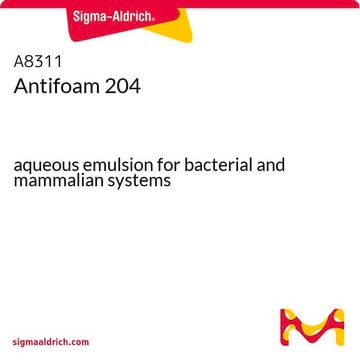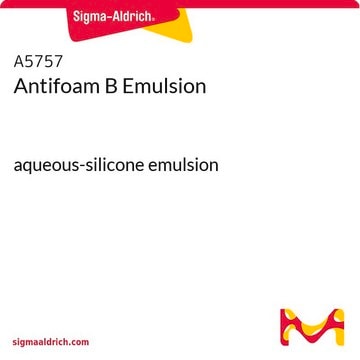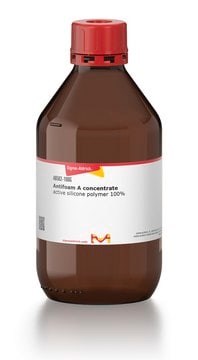Antifoam 204 is a foam suppressor and should be added to the medium from the start, prior to the point when foaming begins.
A6426
Antimousse 204
mixture of organic polyether dispersions
Synonyme(s) :
organic antifoam
Sélectionner une taille de conditionnement
56,90 €
Sélectionner une taille de conditionnement
About This Item
56,90 €
Produits recommandés
Source biologique
synthetic
Forme
liquid
Technique(s)
microbiological culture: suitable
Viscosité
400 cP(lit.)
Densité
1.01 g/cm3 at 25 °C (lit.)
Température de stockage
room temp
Vous recherchez des produits similaires ? Visite Guide de comparaison des produits
Catégories apparentées
Description générale
Application
Caractéristiques et avantages
- Tensioactif particulièrement polyvalent pour vos recherches en biologie cellulaire et en biochimie.
- Convient à la culture microbiologique.
Autres remarques
Code de la classe de stockage
10 - Combustible liquids
Classe de danger pour l'eau (WGK)
WGK 3
Point d'éclair (°F)
Not applicable
Point d'éclair (°C)
Not applicable
Faites votre choix parmi les versions les plus récentes :
Déjà en possession de ce produit ?
Retrouvez la documentation relative aux produits que vous avez récemment achetés dans la Bibliothèque de documents.
Les clients ont également consulté
-
I would like to know whether Antifoam 204 should be added to the medium right from the start or whether it can be added later. More precisely, I am interested in whether the product tends to prevent the formation of foam or can remove existing foam.
1 answer-
Helpful?
-
-
What is the molecular weight of this product? Mean and dispersion? We are trying to assess passage through membranes.
1 answer-
The molecular weight is not determined for this product. An internal note suggests the antifoam's molecular weight is approximately 3,000 daltons, but this is not verified.
Helpful?
-
-
How is shipping temperature determined? And how is it related to the product storage temperature?
1 answer-
Products may be shipped at a different temperature than the recommended long-term storage temperature. If the product quality is sensitive to short-term exposure to conditions other than the recommended long-term storage, it will be shipped on wet or dry-ice. If the product quality is NOT affected by short-term exposure to conditions other than the recommended long-term storage, it will be shipped at ambient temperature. As shipping routes are configured for minimum transit times, shipping at ambient temperature helps control shipping costs for our customers. For more information, please refer to the Storage and Transport Conditions document: https://www.sigmaaldrich.com/deepweb/assets/sigmaaldrich/marketing/global/documents/316/622/storage-transport-conditions-mk.pdf
Helpful?
-
-
How can I determine the shelf life / expiration / retest date of this product?
1 answer-
If this product has an expiration or retest date, it will be shown on the Certificate of Analysis (COA, CofA). If there is no retest or expiration date listed on the product's COA, we do not have suitable stability data to determine a shelf life. For these products, the only date on the COA will be the release date; a retest, expiration, or use-by-date will not be displayed.
For all products, we recommend handling per defined conditions as printed in our product literature and website product descriptions. We recommend that products should be routinely inspected by customers to ensure they perform as expected.
For products without retest or expiration dates, our standard warranty of 1 year from the date of shipment is applicable.
For more information, please refer to the Product Dating Information document: https://www.sigmaaldrich.com/deepweb/assets/sigmaaldrich/marketing/global/documents/449/386/product-dating-information-mk.pdfHelpful?
-
-
Can we dilute the ANTIFOAM 204 with miliQ water in order to minimize its viscosity ?
1 answer-
Yes, it can be diluted. In fact, for use in microbiological media, it is recommended to use a starting concentration of between 0.005% and 0.01%. The optimal amount of antifoam required for various applications will need to be determined. Antifoam 204 is soluble in methanol, ethanol, toluene, xylene, perchloroethylene, and cold water at temperatures below 15 °C. It is insoluble in warm water and ethylene glycol.
Helpful?
-
-
May i ask if you have the toxicological safety data (such as LD50) of Antifoam 204 (Cat # A6426)?
1 answer-
The toxicological data can be found in Section 11 of the Safety Data Sheet. This document may be accessed by entering the product number in the SDS section at the link below: https://www.sigmaaldrich.com/documents-search?tab=sds
Helpful?
-
-
I am using Antifoam 204 in vaccine fermentation process as an antifoaming agent. Regulatory expectation is to varify residual content of 204 in final product. Do you have any suggestion on which analytical method should one explore for such a characteriza
1 answer-
This product is intended for research use only. It is not suitable for human or veterinary use. Unfortunately, a method for residual detection is not available. However, a brief search of the literature reveals that several methods may be deployed, including LC/MS/MS and LS/CAD. Please see the links below to review publications regarding testing for residual amounts of antifoam.
https://onlinelibrary.wiley.com/doi/pdf/10.1002/j.2050-0416.1977.tb06809.x
https://www.eurofinsus.com/media/447588/9207_residual_impurities_bioprocessing.pdf
https://www.bioprocessintl.com/process-monitoring-and-controls/analytical-strategies-for-monitoring-residual-impurities-encountered-in-bioprocessingResidual level tests for antifoam may require a dedicated piece of equipment due to the antifoam properties.
Various general recommendations may be of interest:
a. Use an antifoam sensor/ probe or pump to measure the amount of antifoam in solution
b. NMR
c. ViscosityHelpful?
-
-
Quelle est la molécule du antifoam 204? Est ce un polyethylene glycol classique?
1 answer-
Antifoam 204 contains 100% active components and is a mixture of organic non-silicone polypropylene-based polyether dispersions. It does not contain mineral oil. The exact composition is considered proprietary by the supplier.
Helpful?
-
-
May I ask if you have the LD50 information of Antifoam 204 (Cat#A6426)?
1 answer-
Unfortunately, there is no LD50 information available for this product. A brief search of the literature revealed a publication that reports an LD50 of > 5000 mg/kg in rats. Please see the link below to review this article:
https://www.sciencedirect.com/science/article/abs/pii/B9781774670088500092Helpful?
-
Active Filters
Notre équipe de scientifiques dispose d'une expérience dans tous les secteurs de la recherche, notamment en sciences de la vie, science des matériaux, synthèse chimique, chromatographie, analyse et dans de nombreux autres domaines..
Contacter notre Service technique









